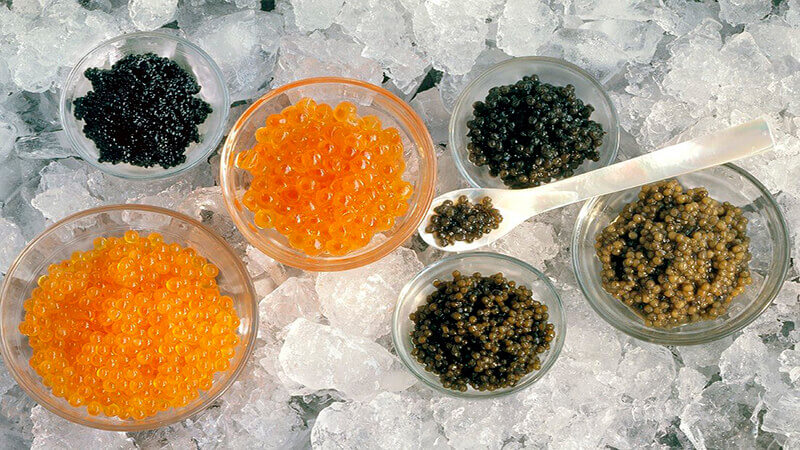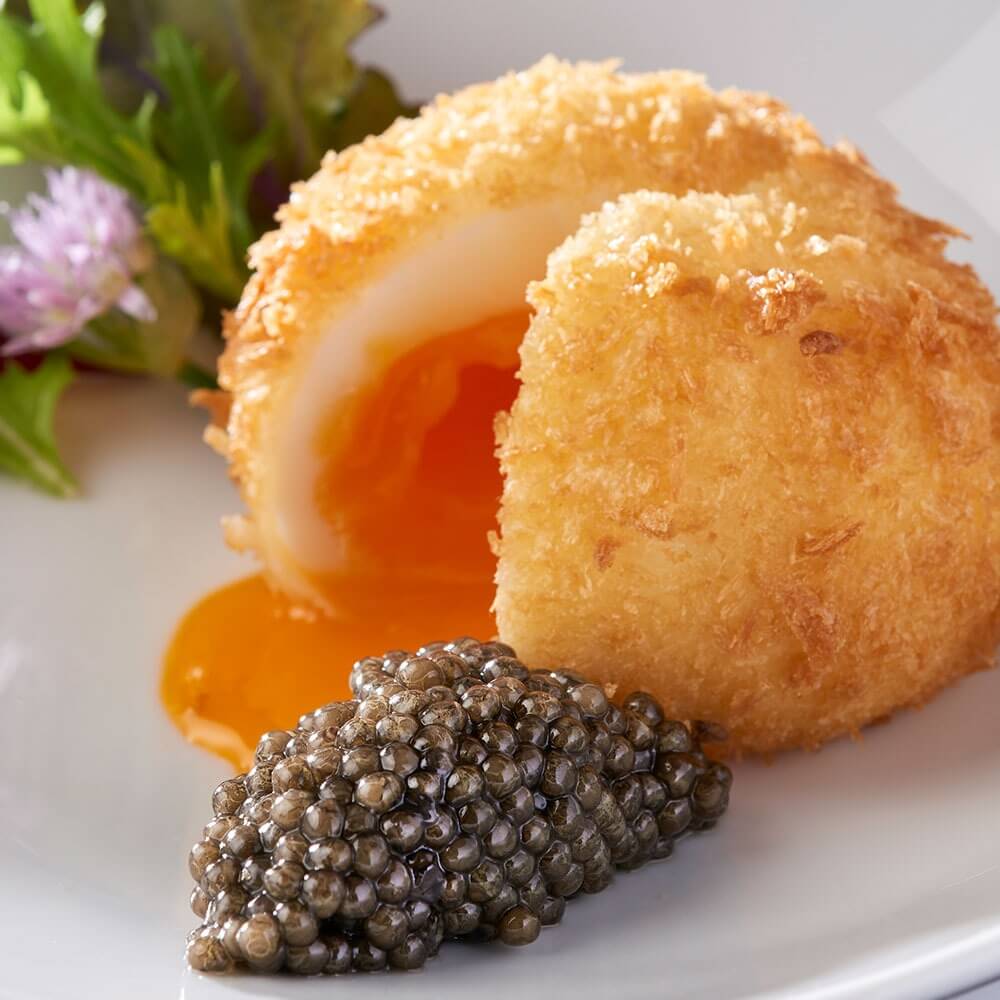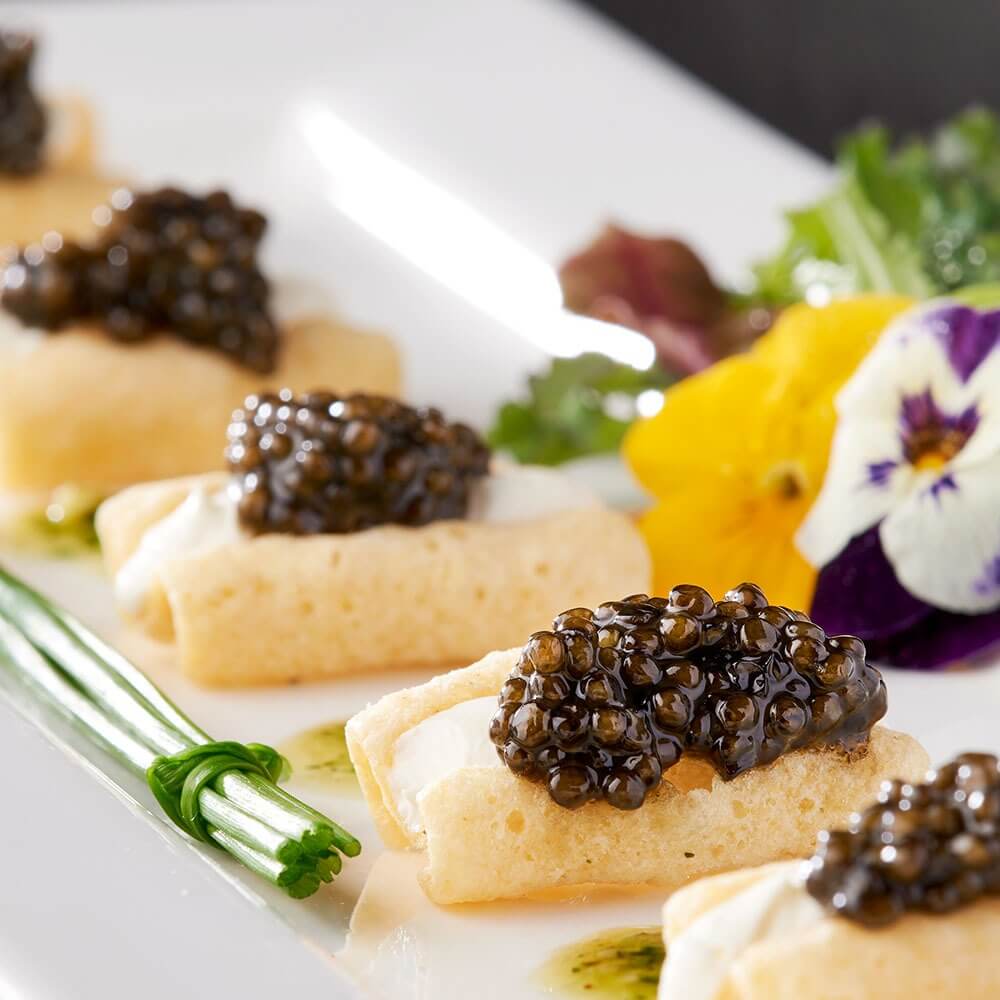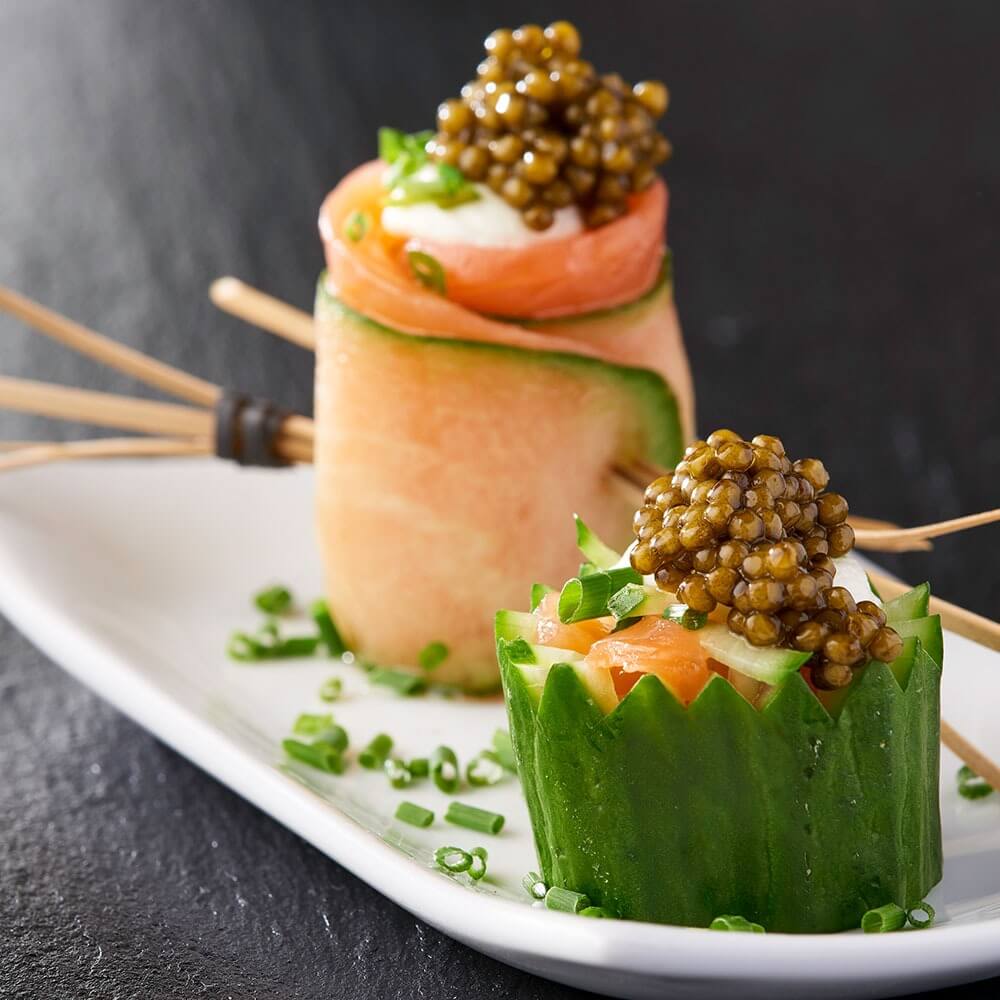
What is Caviar?
Sturgeon eggs, known as caviar, represent one of the most valuable delicacies on the world’s food market. As of 1997, all sturgeon species were included in the Appendices of the Convention on International Trade in Endangered Species (CITES). Since then, sturgeon species identification has been a challenge of primary importance. The standard for sturgeon caviar adopted in 2010, indicates that caviar is the product made from fish eggs, treated with grade salt, of the Acipenseridae family (including the genera Acipenser, Huso, Pseudoscaphirhynchus and Scaphirhynchus). In regards to the labeling of commercial products, the term “caviar” must be used only for sturgeon eggs and labels should include the common name of the species, such as Beluga for Huso huso, Osetra for Acipenser gueldenstaedtii/A. persicus and Sevruga for Acipenser stellatus.
How many types of caviar are there?
Types of caviar Can Be Classified by Preparation:
1. Malossol
The literal translation of the Russian term malossol is 'little salt', and it's used to show that the fish roe was processed using the least amount of salt possible. Many agree that less salt is better for the quality of the caviar, but less salt also means that the caviar becomes highly perishable and therefore more expensive.
2. Salted
When you think about it, all types of caviar are salted caviar, but most connoisseurs prefer the previously mentioned malossol with less salt content to the 'salted' versions, but for those who like this kind, there are different salted caviar types to choose from including pressed and pasteurized caviar.
3. Pressed
Also known as payusnaya or pajusnaya, this type of caviar is made from weak, broken, or damaged caviar eggs that pass through the sieving process. They are then treated, salted, and pressed to produce caviar that has a jam-like consistency and is mostly used in recipes or as a spread.
4. Pasteurized
This type of caviar is firmer than the other types. The caviar is heat treated and then vacuum packed into glass jars to preserve it. This process may affect the taste and texture of the caviar.
Types of caviar Can Also Be Classified by The Fish Species That It Comes From:
- Beluga (Sturgeon): Produced by the biggest fresh water fish, this caviar has big, pea-sized eggs that are clear, glossy, and soft. It has a creamy taste and colors range from light gray to black. Considered to be the highest premium grade there is, Beluga is endangered and currently illegal in the US.
- Ossetra (Sturgeon): Also spelled Ossetra, Asestra, or Oscietra, this caviar has medium-sized eggs the size of BBs. They range in color from light gray to dark brown and sometimes come in golden brown. This variety of caviar has a nutty flavor and gives a salty richness that tastes of the sea.
- Sevruga (Sturgeon): This caviar has smaller eggs than Beluga or Ossetra but it is found in more abundance than the other two, and it also comes at a less expensive price. The roe ranges in color from light gray to black and it has a taste that is slightly similar to Beluga in its butteriness except that it's saltier, richer, and much more intense.
The most popular caviar
Aside from the primary criterion (taste) for quality, caviar benefits from the consumer appeal of scarcity and price, which have some relation to quality. The most popular caviars are:
The rarest and most expensive caviar is the golden caviar of the Ossetra sturgeon.
The beluga sturgeon's eggs are quite large, ranging from dark gray to black, with a buttery and briny taste, and are the most expensive among the most common caviar types.
The Russian and Persian sturgeon's eggs, Ossetra, are somewhat smaller, ranging in color from brown to gray, and more intensely-flavored.
The stellate sturgeon's eggs, Sevruga, are tiny pinhead size, half as large as beluga, and very briny.
Russians also enjoy the small-grained roe of other sturgeon such as the Ship and river sterlet. Good black caviar can be made from the roe of many of the 27 species of sturgeon.
The three largest sturgeon species, the beluga, the kaluga sturgeon (from the Amur River on the Sino-Russian border) and the white sturgeon, produce relatively large, dark gray eggs. Kaluga is sometimes passed off as beluga, but lacks the latter's flavor intensity. The white sturgeon's caviar is slightly smaller, with a very intense flavor.
Types of Ossetra caviar

Ossetra has long been hailed as one of the most coveted varieties of caviar since it was originally found in the Caspian Sea.
Traditional Russian and Persian Osetra (sometimes spelled "Ossetra") was harvested from sturgeons captured in the Caspian Sea. Now that overfishing and poaching have decimated the natural population of Caspian sturgeons, bringing them to the point of extinction, the commercial use of wild-caught sturgeons is strictly regulated. Most of the world's commercial caviar comes from state of the art aquafarms. Ossetra Caviar is graded by size and color. The larger the eggs, the lighter the color, the more valuable the caviar is. The Gold color is a naturally occurring but unpredictable characteristic of Osetra (Acipenser Gueldentsaedtii).
These alterations and color diversity are attributed to the uniqueness of these sturgeons and the reason why Ossetra is so highly appreciated by caviar connoisseurs. Gold color eggs will not occur in any other “Ossetra” caviar. This is why Persian and Russian Sturgeon is also the most valuable among other sturgeons whose caviar is incorrectly called Ossetra.

Types of Beluga caviar
The famed caviar from the huso huso sturgeon, Beluga caviar has forever been synonymous with epicurean luxury, always sought after by chefs and connoisseurs, the food of royalty and movie stars. The large and buttery caviar pearls were once served in first class flights and the best hotels and restaurants in the world.
The difference between caviar varieties and types lies in the size of the eggs and the color of the caviar. Through years of experience and an eye for detail, the caviar experts at Saaee collection have succeeded in making a selection for our customers.
Types of Sevruga caviar
Sevruga caviar is traditionally graded by size and color. The larger and lighter the grains, the more valuable the caviar.
Sevruga is one of the sturgeon family's most amply represented members in the world's supply of caviar. Next to the imposing proportions of its larger relatives, such as Ossetra or Beluga, this fish is rather small, reaching up to 2 m in length and weighing up to 80 kg. The Sevruga sturgeon's slender form is emphasized by a long and narrow snout with five small, moustache-like barbels near the mouth. Sevruga is not so long-lived as Ossetra, Beluga or Kaluga. Its shorter lifespan – up to 25 years – is in fact one of its advantages, as it is accompanied by a correspondingly short maturation period and increased rate of reproduction. In the wild, this fish lives in the basins of the Caspian, Azov, Black, and Aegean Seas and adjacent large rivers.
Due to its faster reproduction and wider geographic span, Sevruga is one of the best represented members of the sturgeon family, not only in aquaculture but also in its natural environment. It supplies more than half of all sturgeon caviar to pass through the international market. This abundance allows it to be by far the least costly among the great caviar-yielding sturgeons. Though it is less expensive than Beluga and Osetra, its relatives, Sevruga caviar delivers the same high quality, beautiful appearance, and delicate flavor expected from these elite species.
Types of Sterlet caviar
Sterlet caviar is a variety harvested from sterlet sturgeon (Acipenser ruthenus)—which is native to rivers that flow into the Caspian Sea, Black Sea, Baltic Sea, Barents Sea, and the Sea of Azov. Sterlet roe has small and delicate eggs that range from light to dark gray. The flavor is mild, subtly sweet, and buttery.
Types of Kaluga caviar
Kaluga Huso dauricus is one of two species of Acipenseriformes endemic to the Amur River Basin, located in the Russian Federation and in China. It is one of the largest species of sturgeon and has a relatively low reproductive rate, reaching sexual maturity at 14-23 years.
Kaluga is Very similar to Beluga in taste and appearance - large and glosssy eggs with a mild and buttery taste.
Types of Hackleback caviar
Hackleback sturgeon (Scaphirhynchus platorynchus) is also known as American sturgeon, but is actually one of eight species (nine including Paddlefish) that are native to the United States. It is characterized by its flattened snout. Its other names include shovelnose sturgeon, switchtail sturgeon and sand sturgeon. Hackleback is the smallest of the river sturgeon species, measuring between 19 to 37 inches in length and weighing between 4 and 8 pounds. It can be found at the bottom of the Missouri and Mississippi river basins, typically where there is a lot of sediment and a swift current. This is an ancestral fish and has not been physiologically changed for millennia, making it a living fossil.
Hackleback caviar is black caviar, but actually may be found in a dark gray color too.
Caviar types ranked
Caviar comes in several different ranks, which refers to the quality of the caviar
The ranking process of caviar is a complex, time consuming one that we at Saaee collection take most seriously.
Saaee caviar offers five grades, starting with then common, Imperial, Imperial selection. Due to the variations between types even within the different grades, there is no single differentiator for determining what makes beluga a Imperial versus a Imperial selection caviar. The ranking process takes time with our caviar experts reviewing each batch for texture, flavor, size, finish, and even color. Once a batch of caviar is graded, it then is ready to be packaged for sale.
Caviar types and prices
Caviar prices vary widely based on quality, season (prices go up during Christmas season due to supply and demand), and individual merchant margins. Products that sound the same can vary in price.
The most expensive caviar
The most expensive of all caviar, and indeed the world's most expensive food is 'Almas', from the Iranian Beluga fish. Almas is produced from the eggs of a rare albino sturgeon between 60-100 years old, which swims in the southern Caspian Sea where there is apparently less pollution.
Caspian Sea Caviars
The sturgeons of the Caspian Sea are considered highly valuable species. The Caspian Sea has traditionally been regarded as the sea of sturgeon since it produced more than 90 percent of the world’s caviar. In the Caspian Sea there are more than 123 species and subspecies of fish in 17 families (Kazancheev, 1981) including five species of sturgeon Acipenser persicus (Persian sturgeon), Acipenser gueldenstadti (Russian sturgeon), Acipenser nudiventris (ship sturgeon), Acipenser stellatus (sevruga), and TABLE 1. Coastline of the Caspian Sea Huso huso (beluga). Their roe is processed into black roe or caviar, one of the most expensive luxury food items obtained from the aquatic environment.
The trade name for caviar from the Persian sturgeon, Russian sturgeon and ship sturgeon is ossetra and the two other types of caviar are named as the sturgeon they come from, i.e. sevruga and beluga.

